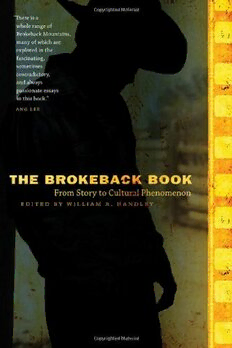Table Of Content{ The Brokeback Book }
From Story to Cultural Phenomenon
edited by william r. handley
University of Nebraska Press Lincoln and London
© 2011 by the Board of Regents
of the University of Nebraska.
Acknowledgments for the use of
copyrighted material appear on page
xii, which constitutes an extension
of the copyright page.
All rights reserved. Manufactured
in the United States of America
Library of Congress
Cataloging-in-Publication Data
The Brokeback book : from story to
cultural phenomenon / edited by
William R. Handley.
p. cm.
Includes bibliographical references
and index.
isbn 978-0-8032-2664-7
(pbk. : alk. paper)
1. Brokeback Mountain (Motion
picture) 2. Proulx, Annie.
Brokeback Mountain. I. Handley,
William R.
pn1997.2.b75b75 2011
791.43'72—dc22 2010038342
Set in Scala and ScalaSans Pro by
Bob Reitz. Designed by A. Shahan.
Some images have been masked due to copyright limitations.
Please refer to the print edition of this book.
This book is about a story and film that depict broken hearts, marriages,
and lives—and generations that barely communicate across the dis-
tances. In Annie Proulx’s story, the relation between fathers and sons,
in particular, is one of violence passed on and inherited, little more.
Proulx has a telling point, and with that in mind I would like to dedicate
this book to people of generations before and after me who represent
the better side of what is possible.
Descendants of nineteenth-century Mormon polygamists, my par-
ents actively support gay civil rights. Given the history of intolerance
toward Mormons, one might think that more in the Latter-Day Saints
(lds) community would share my parents’ views or at least refrain from
efforts to deny civil rights to others—but of course both the lds defense
of polygamy and the (so far) successful attempts of the lds church and
other religious organizations constitutionally to overturn civil marriage
equality in California and elsewhere stem from religious belief. In my
teens I heard each of my parents speak before our lds congregation in
Connecticut against racial prejudice and against prejudice toward those
whose sexual orientations are different. I do not know what makes them
the way they are, but like any son or daughter, I’ve long observed what
my parents do. With many of their friends in their seventies and eight-
ies, in Salt Lake City where they now live, they work to make progress
toward a more civil, healthy, and humane society—on issues from gay
rights to gun control, from health care to environmental conservation—
despite a recalcitrant state legislature and a large church influence. Dixie
v
and Bob Huefner, Ann and Gale Dick, Norma and Ron Molen, Millie
and Gary Watts, my parents Kate and Ken, and many others represent
to me what is best about westerners—courageous stewards of the future
who deal cheerfully and persistently against difficult odds, and who do
not forget the past.
I dedicate this book to them and to others like them—and to a moun-
tain man and environmental and civil rights activist out West, Dave
Stalling (whom this book allowed me to know after so many years since
junior high school), and to his personal hero, his son Cory.
vi
Contents
List of Illustrations x
Acknowledgments xi
Introduction: The Pasts and Futures of a Story
and a Film 1
william r. handley
Part 1. Gay or Universal Story? Initial Debates and
Cultural Contexts
1. Men in Love: Is Brokeback Mountain a Gay Film? 27
david leavitt
2. An Affair to Remember 31
daniel mendelsohn
3. Response to “An Affair to Remember” 39
james schamus
4. The Magic Mountain 42
andrew holleran
5. Backs Unbroken: Ang Lee, Forbearance,
and the Closet 52
mun-hou lo
Part 2. Miles to Go and Promises to Keep: Homophobic
Culture and Gay Civil Rights
6. Back to the Ranch Ag’in: Brokeback Mountain and
Gay Civil Rights 81
james morrison
7. Breaking No Ground: Why Crash Won, Why Brokeback
Lost, and How the Academy Chose to Play It Safe 101
kenneth turan
8. “Jack, I Swear”: Some Promises to Gay Culture from
Mainstream Hollywood 103
chris freeman
9. “Better Two Than One”: The Shirts from Brokeback
Mountain 118
gregory hinton
10. American Eden: Nature, Homophobic Violence, and
the Social Imaginary 123
colin carman
11. West of the Closet, Fear on the Range 137
alex hunt
Part 3. Adapting “Brokeback Mountain,” Queering the Western
12. Interview between Michael Silverblatt and
Annie Proulx 153
13. In the Shadow of the Tire Iron 163
alan dale
14. Adapting Annie Proulx’s Story to the Mainstream
Multiplex 179
adam sonstegard
15. Not So Lonesome Cowboys: The Queer Western 190
judith halberstam
Part 4. Public Responses and Cultural Appropriations
16. “One Dies, the Other Doesn’t”: Brokeback and
the Blogosphere 205
noah tsika
17. Making Sense of the Brokeback Paraphenomenon 229
david weiss
18. Alberta, Authenticity, and Queer Erasure 249
jon davies
Part 5. Scenes of Work and Experience in the Rural West
19. Real Gay Cowboys and Brokeback Mountain 267
patricia nell warren
20. Marx on the Mountain: Pleasure and the
Laboring Body 283
vanessa osborne
21. Personal Borders 299
martin aguilera
Part 6. Sympathy, Melodrama, and Passion
22. Mother Twist: Brokeback Mountain and Male
Melodrama 309
susan mccabe
23. Passion and Sympathy in Brokeback Mountain 321
calvin bedient
Selected Brokeback Bibliography 351
Works Cited 353
Contributors 371
Index 377

